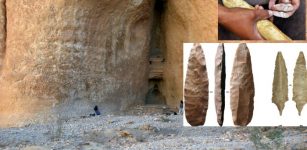Strange Tuxtla Statuette And Its Undeciphered Inscription – An Epi-Olmec Puzzle
Ellen Lloyd - AncientPages.com - The Tuxtla statuette is a strange ancient artifact left by a culture we still know very little about. Who was this bullet-shaped being with wings wearing a duckbill mask? Is the undeciphered script on the statuette some charm or magical incantation?
A side view of the Tuxtla Statuette. Credit: Wikipedia
This curious artifact was discovered in 1902 by a farmer plowing his field in the western foothills of the Tuxtlas mountains in Veracruz, Mexico. Examinations of the statuette revealed it was an artifact made by the Epi-Olmec culture. Certain Maya scholars had difficulties accepting the artifact pre-date the Maya, but upon further investigations, scholars confirmed the antiquity of the Tuxtla statuette.
The Epi-Olmec culture was a successor culture to the Olmec. They lived in the central region of the present-day Mexican state of Veracruz from about 300 B.C to roughly 250 C.E.
The Epi-Olmec culture never attained the far-reaching achievements as the Olmec, but they did develop sophisticated calendars and writing system.
Their mysterious Isthmian script still remains undeciphered. The Isthmian script is structurally similar to the Maya script, and like Maya uses one set of characters to represent logograms (or word units) and a second set to represent syllables. This suggests these two writing systems developed together. Both systems have the Long Count calendrical system fixed with a zero date. This type of Meso-American writing was often used to record specific events and carved on stone stelae that serve as durable memorials to rules and symbols of political and religious legitimacy.
Frontal view of the Tuxtla Statuette. Note the Mesoamerican Long Count calendar date of March 162 CE (8.6.2.4.17) down the front of the statuette. Credit: Wikipedia
Unfortunately, there are very few surviving examples of the Isthmian script, making the deciphering process even harder.
Tuxtla statuette is incised with 75 glyphs. Its glyphs include the Mesoamerican Long Count calendar date of March 162 AD, which in 1902 was the oldest Long Count date yet discovered. The round statuette is only 6 inches (16 cm) and made of nephrite, greenstone, similar to jade, but not as hard.
The problem is that no-one really knows who the Tuxtla statuette depicts. Most researchers believe the statuette represents a shaman wearing a bird mask and bird cloak.
Written by Ellen Lloyd – AncientPages.com
Updated on July 10, 2021
Copyright © AncientPages.com All rights reserved. This material may not be published, broadcast, rewritten or redistributed in whole or part without the express written permission of AncientPages.com
More From Ancient Pages
-
 Genetic Fingerprints Of Unknown Species Discovered In Human DNA
Human Beginnings | Dec 31, 2019
Genetic Fingerprints Of Unknown Species Discovered In Human DNA
Human Beginnings | Dec 31, 2019 -
 Mystery Surrounds Newly Discovered Bronze Age Burial In Southwest England
Archaeology | May 21, 2018
Mystery Surrounds Newly Discovered Bronze Age Burial In Southwest England
Archaeology | May 21, 2018 -
 On This Day In History: Fatal Fire Broke Out In Tre Kronor “Three Crowns” Castle, Stockholm, Sweden – On May 7, 1697
News | Dec 7, 2021
On This Day In History: Fatal Fire Broke Out In Tre Kronor “Three Crowns” Castle, Stockholm, Sweden – On May 7, 1697
News | Dec 7, 2021 -
 Mystery Of Human Evolution – What Can Ancient Genes Tell Us About Who We Are?
Archaeology | Jun 2, 2022
Mystery Of Human Evolution – What Can Ancient Genes Tell Us About Who We Are?
Archaeology | Jun 2, 2022 -
 Mysterious Ancient Female Society Discovered – What Happened To All The Men? Archaeologists Wonder
Featured Stories | Oct 3, 2024
Mysterious Ancient Female Society Discovered – What Happened To All The Men? Archaeologists Wonder
Featured Stories | Oct 3, 2024 -
 Secrets Of Ancient Underwater City Pavlopetri Revealed – Travel Back In Time And See What The City Looked Like!
Archaeology | Mar 1, 2014
Secrets Of Ancient Underwater City Pavlopetri Revealed – Travel Back In Time And See What The City Looked Like!
Archaeology | Mar 1, 2014 -
 Evidence Reveals Ancient Saudi Arabia Had A Complex, Thriving Society, Contradicting Notions Of A Struggling Population In Barren Lands
Featured Stories | Aug 21, 2024
Evidence Reveals Ancient Saudi Arabia Had A Complex, Thriving Society, Contradicting Notions Of A Struggling Population In Barren Lands
Featured Stories | Aug 21, 2024 -
 Starkad The Viking – Legendary Norse Hero Who Was Both Blessed And Cursed By Gods
Featured Stories | Jul 29, 2019
Starkad The Viking – Legendary Norse Hero Who Was Both Blessed And Cursed By Gods
Featured Stories | Jul 29, 2019 -
 Boobrie: Shape-Shifting Mythical Horror Bird From Scottish Highlands
Featured Stories | Feb 9, 2017
Boobrie: Shape-Shifting Mythical Horror Bird From Scottish Highlands
Featured Stories | Feb 9, 2017 -
 Secrets About ‘Tennessee’s Ancient Egyptian Temple’ Revealed
Civilizations | Aug 15, 2018
Secrets About ‘Tennessee’s Ancient Egyptian Temple’ Revealed
Civilizations | Aug 15, 2018 -
 Biblical Cherubim – Sweet Angels Or Dangerous Creatures With A Hidden Agenda?
Ancient Mysteries | Jun 9, 2018
Biblical Cherubim – Sweet Angels Or Dangerous Creatures With A Hidden Agenda?
Ancient Mysteries | Jun 9, 2018 -
 World Map Of Neanderthal And Denisovan DNA In Modern Humans
DNA | Apr 13, 2023
World Map Of Neanderthal And Denisovan DNA In Modern Humans
DNA | Apr 13, 2023 -
 Enigma Of The Missing Pyramid Bodies – Ancient Egyptian Mystery Remains Unsolved
Ancient Mysteries | Dec 10, 2018
Enigma Of The Missing Pyramid Bodies – Ancient Egyptian Mystery Remains Unsolved
Ancient Mysteries | Dec 10, 2018 -
 Mysterious Maya Snake Kings And Their Powerful Kingdom In The Jungle Reveal More Ancient Secrets
Civilizations | Apr 23, 2018
Mysterious Maya Snake Kings And Their Powerful Kingdom In The Jungle Reveal More Ancient Secrets
Civilizations | Apr 23, 2018 -
 Odin: Norse God Of War And Magic – Most Complex Figure Of The Norse Pantheon
Myths & Legends | Oct 27, 2016
Odin: Norse God Of War And Magic – Most Complex Figure Of The Norse Pantheon
Myths & Legends | Oct 27, 2016 -
 Oldest Human Genome From The Iberian Peninsula Helps Reconstructing Human History
Archaeology | Mar 1, 2023
Oldest Human Genome From The Iberian Peninsula Helps Reconstructing Human History
Archaeology | Mar 1, 2023 -
 Independent Invention: Iconic Native American Stone Tool Technology Discovered In Arabia
Archaeology | Aug 6, 2020
Independent Invention: Iconic Native American Stone Tool Technology Discovered In Arabia
Archaeology | Aug 6, 2020 -
 Secrets Of Ark of The Covenant Revealed In Ancient Manuscript
Biblical Mysteries | Jul 19, 2014
Secrets Of Ark of The Covenant Revealed In Ancient Manuscript
Biblical Mysteries | Jul 19, 2014 -
 Viking Treasures Discovered In Chamber Grave In Denmark
Archaeology | Apr 4, 2017
Viking Treasures Discovered In Chamber Grave In Denmark
Archaeology | Apr 4, 2017 -
 Mediterranean Hunter-Gatherers Relied On Marine Resources More Than Previously Thought
Archaeology | Feb 22, 2023
Mediterranean Hunter-Gatherers Relied On Marine Resources More Than Previously Thought
Archaeology | Feb 22, 2023


